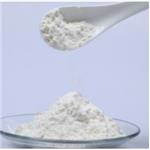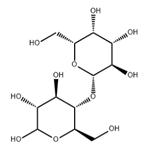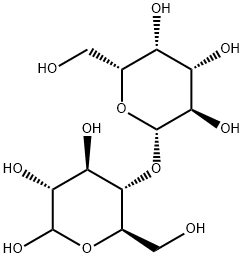Preparation, application and healthy benefits of lactose
General description
Lactose is a type of sugar that is found in milk and milk products, including human milk. Also called milk sugar, it is not found naturally in any other food. This sugar is made of carbon, hydrogen and oxygen, and it has the chemical formula of C12H22O11 [1]. By the time they are adults, many people become unable to digest milk sugar, which is a condition called lactose intolerance. Moreover, lactose also can be found in many ready-to-eat powdered products, such as dehydrated potatoes, soups and meal-replacement supplements. Foods that are labeled non-dairy, including coffee creamers, might also contain it in the form of whey or dry milk solids. It also can be found in some salad dressings, protein supplements, candy and processed meats [2].

Fig. 1 Alpha lactose (4-O-β-D-galactosylpyranosyl-α-d-glucose).
Source
The quantity of lactose in milk can vary by the type of animal as well as the individual animal or person. Human milk generally has a higher percentage— usually about 7% to 9%, by weight — than milk from animals does [3]. Milk from cows, goats and sheep, for example, typically are less than 5% lactose by weight. For most processed dairy milk, the lower fat content, the higher the percentage of milk sugar there is in it.
This sugar is found to various degrees in other dairy products, such as cheese, butter or margarine, yogurt, whey and powdered milk. There is very little of it in cheese, butter and margarine. Whey, powdered milk and condensed milk, however, contain a very high percentage of this sugar — 50% or more, in some cases. The milk sugar content of yogurt can vary but generally is about 2% to 6% [4].
Preparation
Lactose is obtained from the whey in milk (about 5% lactose) by heating or lime milk processing, and after the removal of protein concentration, cooling, crystallization and drying. The yield was about 60% ~ 70% [5].
Application
Lactose is often added to prepared foods to prevent caking or as a coating. This sugar is almost tasteless, so it also makes for an ideal filler in bread and other baked goods, including cereals, pancakes and cookies [6]. It also is commonly added to canned and frozen vegetables to prevent discoloration. The type of milk from which this sugar is extracted can vary by country or region, with that of cows, goats and camels being the most common.
Especially, lactose is a unique disaccharide, which occurs exclusively in the milk of mammals. It has wide applications as a food ingredient and in pharmaceutical preparations. Discouragement of milk consumption, because of the existence of lactase deficiency in the majority of the world population, is unjustified, because even in the complete absence of this enzyme, nutritionally significant volumes of milk, corresponding to about 11 g of lactose per day, are well tolerated, if the milk intake is distributed over the day and combined with meals [7]. Lactose has interesting nutritional properties. These include a relatively low sweetening power, calorific value and glycemic index. It also has dietary fibre-like and prebiotic properties and enhances the absorption of calcium and magnesium. Its cariogenicity is low compared with that of other simple carbohydrates. The lactose derivatives lactulose, lactitol and galacto-oligosaccharides find applications in foods and pharmaceutical preparations as prebiotics to promote gut health. Similarly to non-digested lactose, these compounds enhance the intestinal absorption of calcium and magnesium. Other lactose-derived compounds (e.g., tagatose and lactobionic acid) have potential applications as bioactive ingredient in foods [8, 9].
Primary adult lactase non-persistence and lactose intolerance
Malabsorption of lactose, resulting from the combination of lactase deficiency and lactose intake levels of more than 10–15 g per day, and giving symptoms of lactose intolerance have often led to the rejection of milk as a food and to discouragement of milk in food aid programs for the third world [10]. This was unjustified, because it is now well accepted that lactase deficient subjects can consume without side effects amounts of lactose up to 11 g per day (one to two portions of milk), when this amount is distributed over the day and ingested with meals, as described in more detail below.
Nutritional benefits of lactose
(1) Sweetness and cariogenicity
The sweetness of lactose, relative to that of other simple sugars. It is only 20–30% of that of sucrose and this is one of the reasons that lactose is a suitable carbohydrate in infant formulas. It is thought that a high sweetness could encourage appetite and overeating and lead to the development of a taste preference for sweet foods in later life. Fermentation of sugars in the oral cavity leads to the formation of organic acids, which may erode the enamel of the teeth and cause caries. Of the different simple sugars, sucrose appeared to be the most cariogenic, not just because it is easily fermented, but also because Streptococcus mutans, a dominant species in the oral flora, forms sticky dextrans from sucrose that contribute to tooth plaque formation. Glucose and maltose may be marginally less cariogenic than sucrose. Lactose and galactose appeared to be less cariogenic than other simple sugars, probably because the acid formation from these sugars in the oral cavity is relatively slow; moreover, the buffering capacity of milk reduces the cariogenicity of lactose [12].
(2) Glycemic index
Long-standing elevated levels of blood glucose increase the risk of cardiovascular diseases. Dietary carbohydrates differ in their effect on the blood glucose concentration and in this regard the glycemic index (GI) is relevant. The effect of dietary lactose, as compared with other carbohydrates, on the blood glucose level has been investigated in a variety of studies related to the measurement of the GI. From a simple comparison of the GIs of different sugars and carbohydrate-containing foods (Table 4), it can be concluded that the GI of lactose is relatively small. Therefore, lactose can have benefits for persons who are sensitive to get hyperglycemia, e.g., diabetic patients and subjects with a decreased sensitivity to insulin. The relatively low GI of lactose is attributable to several factors. Firstly, lactose is often incompletely digested in the small intestine. Secondly, the galactose monosaccharide component has to be converted into glucose in the liver before it can contribute to the blood glucose level [13].
(3) Dietary fibre-like activities and prebiotic effects
Non-digested lactose will increase the water content of stools and reduce transit time in constipated subjects. More recently prebiotic effects of lactose received attention. Lactose that escapes digestion will serve a substrate for the intestinal flora and enhance saccharolytic activities and favour the growth of bifidobacteria and lactobacilli. Saccharolytic activities are known to be associated with the formation of volatile fatty acids, lowering of the luminal pH and decreased formation of the toxic secondary bile acids. Stimulation of saccharolytic activities will depress microbial proteolytic activities, which are known to be associated with the formation of toxic bacterial metabolites, like ammonia, hydrogen disulphide, phenolic compounds and biogenic amines (Salminen et al., 1998). Non-digestible lactose derivatives, including lactulose, lactitol, lactobionic acid, galacto-oligosaccharides (GOS) and tagatose, are known to have similar effects as lactose that has escaped digestion [14].
Precautions for taking lactose
In a normal person, lactase, an enzyme produced by the small intestine, breaks down milk sugar. This allows it to be absorbed into the bloodstream. People who are lactose intolerant do not produce enough lactase and are therefore unable to process milk sugar. As a rule, mammals lose their ability to digest milk sugar as they get older. Humans have undergone a mutation that allows them to retain a 10% capacity to produce lactase [15]. This is normally enough to allow humans to digest milk and dairy products. Some people, however, don't retain this capacity and become intolerant of milk sugar. When someone who has this condition drinks milk or consumes products that contain more than a little lactose, they might experience symptoms such as bloating, cramps, nausea, flatulence and diarrhea [16].
References
[1] J.C. Kolars, M.D. Levitt, M. Aouji, D.A. Savaiano, Yogurt—an autodigesting source of lactose, New England Journal of Medicine 310(1) (1984) 1-3.
[2] N. Seki, H. Saito, Lactose as a source for lactulose and other functional lactose derivatives, International Dairy Journal 22(2) (2012) 110-115.
[3] S. Suri, V. Kumar, R. Prasad, B. Tanwar, A. Goyal, S. Kaur, Y. Gat, A. Kumar, J. Kaur, D. Singh, Considerations for development of lactose-free food, Journal of Nutrition & Intermediary Metabolism 15 (2019) 27-34.
[4] A. Martinez-Ferez, S. Rudloff, A. Guadix, C.A. Henkel, G. Pohlentz, J.J. Boza, E.M. Guadix, C. Kunz, Goats’ milk as a natural source of lactose-derived oligosaccharides: Isolation by membrane technology, International Dairy Journal 16(2) (2006) 173-181.
[5] M. Acik, F.P. ÇAKIRO?LU, M. Altan, T. BAYBO, Alternative source of probiotics for lactose intolerance and vegan individuals: sugary kefir, Food Science and Technology 40 (2020) 523-531.
[6] F. Rico-Rodríguez, M. Villamiel, L. Ruiz-Aceituno, J.C. Serrato, A. Montilla, Effect of the lactose source on the ultrasound-assisted enzymatic production of galactooligosaccharides and gluconic acid, Ultrasonics Sonochemistry 67 (2020) 104945.
[7] M.S. Buchowski, D.D. Miller, Lactose, calcium source and age affect calcium bioavailability in rats, The Journal of nutrition 121(11) (1991) 1746-1754.
[8] A. Amrane, Y. Prigent, Lactic acid production from lactose in batch culture: analysis of the data with the help of a mathematical model; relevance for nitrogen source and preculture assessment, Applied microbiology and biotechnology 40(5) (1994) 644-649.
[9] P. Fox, Lactose: Chemistry and properties, Advanced dairy chemistry, Springer2009, pp. 1-15.
[10] R.G. Montes, J.A. Perman, Lactose intolerance: pinpointing the source of nonspecific gastrointestinal symptoms, Postgraduate Medicine 89(8) (1991) 175-184.
[11] J. Zhao, Z. Zhang, S. Zhang, G. Page, N.W. Jaworski, The role of lactose in weanling pig nutrition: a literature and meta-analysis review, Journal of animal science and biotechnology 12(1) (2021) 1-17.
[12] R. Leis, R. Tojo, P. Pavón, A. Douwes, Prevalence of lactose malabsorption in Galicia, Journal of pediatric gastroenterology and nutrition 25(3) (1997) 296-300.
[13] S. Povolo, S. Casella, Bacterial production of PHA from lactose and cheese whey permeate, Macromolecular symposia, Wiley Online Library, 2003, pp. 1-10.
[14] D.L. Swagerty Jr, A. Walling, R.M. Klein, Lactose intolerance, American family physician 65(9) (2002) 1845.
[15] V. Gekas, M. Lopez-Leiva, Hydrolysis of lactose: a literature review, Process Biochem.;(United Kingdom) 20(1) (1985).
[16] V.H. Holsinger, Lactose, Fundamentals of dairy chemistry, Springer1988, pp. 279-342.
);You may like
See also
Lastest Price from Lactose manufacturers

US $30.00-20.00/kg2024-04-30
- CAS:
- 63-42-3
- Min. Order:
- 10kg
- Purity:
- 99.99%
- Supply Ability:
- 100Tons

US $9.00-6.00/kg2024-04-30
- CAS:
- 63-42-3
- Min. Order:
- 1kg
- Purity:
- 99%
- Supply Ability:
- 8000kg


